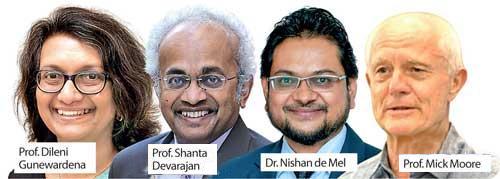Reply To:
Name - Reply Comment
By Shabiya Ali Ahlam
 The leading economists of the Verite Research Sri Lanka Economic Policy Group (SLEPG) called on the relevant authorities to steer away from using Samurdhi as a determinant of eligibility for welfare benefits and instead, consider electricity consumption for targeting vulnerable groups, as it is a superior method.
The leading economists of the Verite Research Sri Lanka Economic Policy Group (SLEPG) called on the relevant authorities to steer away from using Samurdhi as a determinant of eligibility for welfare benefits and instead, consider electricity consumption for targeting vulnerable groups, as it is a superior method.
The recommendation, put forward by Prof. Dileni Gunewardena, Prof. Mick Moore, Dr. Nishan de Mel and Prof. Shanta Devarajan, asserted that given the poor performance of the Samurdhi programme and a large number of citizens made vulnerable by the crisis, ensuring efficient targeting must be a key priority for any new social protection measures.
The latest policy note by the SLEPG recommended that a household electricity use threshold of 60kwh per month is utilised as a determinant of eligibility for welfare benefits.
This is one of several indicators previously identified by the Sri Lankan government, through a gazette notification in 2019, as the potential components of a proxy means test to identify the low-income families for welfare benefit payments.
About 99 percent of households in Sri Lanka are connected to the national grid and 48 percent of the population live in households that consume 60kWh or less of electricity in a month, the policy
note highlighted.
“Using this threshold to determine eligibility for cash transfers or other welfare benefits would ensure coverage of approximately 50 percent of the population,” the SLEPG said in its latest policy note.
The analysis by Verite Research shows that focusing on the poorest 20 percent of the population, the electricity use criterion includes a far greater proportion of the vulnerable population than the existing Samurdhi programme.
For the poorest 10 percent of the population, the most vulnerable group, targeting via the electricity use criterion captures 81 percent of households. The Samurdhi system only captures
40 percent.
More than twice as many households are captured through this improved targeting mechanism. This pattern is repeated at the second poorest decile
as well.
“Household electricity use is a much better indicator of poverty than being a Samurdhi recipient,” the SLEPG affirmed.
The policy group also pointed out three other reasons for the government to adopt household electricity consumption as an indicator of poverty. They are: (1) It can be implemented quickly, easily and cheaply as 99 percent of households are connected to the Ceylon Electricity Board (CEB) grid and their monthly electricity use is already tracked and available in digital form; (2) eligibility can be continuously adjusted to reflect changes in household circumstances and (3) politicisation and corruption can be largely eliminated.
According to the SLEPG, the efficiency of this mechanism could be further improved if the implementing agencies were able to identify and exclude from the cash transfer programme households that rely on solar power generation for household use and thereby consume less than 60kWh from the national grid.
The same applies to households that have two or more electricity meters on different floors.
“These two corrective measures would reduce the number of households among the richest 20 percent of households, who might otherwise wrongly receive cash transfers,” the SLEPG said.